The work of a designer is a union of knowledge, skills, experience and a bright personality. All this should be reflected consistently and expressively in the resume. You should not turn the standard description into a carnival, but still your taste and ability to express yourself should feel in the text.
Structure
The work of the designer is the beautification of the external world, its specific manifestations. The resume of a specialist depends on the direction of his activity and on what skills he already has. And for the web designer, and for the designer of clothes (interior, printing, landscape, industrial ...) It is important to have a portfolio that will best illustrate the resume.

Resume structure.
- Submission, contact details. Write, for example: Elena Grigoryeva, layout designer. 07/12. Born in 1991 Indicate the phone number for communication, email address, messenger, etc. If you are already an experienced specialist, it is appropriate to leave your professional creed here. For example, “I do beautifully, I do convincingly, I do From and To.” If you are a designer without experience, such posts will be inappropriate.
- Education. Indicate where you studied the profession. If, in addition to basic education, you still have a lot of certificates from courses and seminars, mark only the key ones that are especially important for growth in the profession. You don’t need to write everything. Correctly mark the years of study.
- Experience. If you get a job, for example, in a printing house, note in your professional experience what will be a promising accumulation specifically for a potential position. If you have previously worked as an artist or, for example, as an architect, mark this in the summary.Perhaps mastered related specialties will make you a more preferable candidate.
- Professional duties. List what you did in your past work. Only the basic functionality, without uninformative details. If you are getting a job as a designer in the industrial sector, but you were previously engaged, for example, in painting scarves, do not draw attention at the last place of work. Indicate neutral information, talk about yourself in general.
- Personal qualities. At this point, write 5-7 of your personal qualities that serve as a support for achieving professional heights. What could it be:
- sociability;
- ability to listen and hear the client;
- scrupulousness;
- purposefulness;
- propensity for continuous self-education;
- openness
- psycho-emotional flexibility. Of course, you need to write only what is really inherent in you.
- Priority areas. Indicate here the profile of the work that is more interesting to you and which is better for you (for example, industrial design). You can also leave a link to a file that will illustrate your projects.
- Professional toolkit. If you leave this item, indicate in which special programs you work, which applications, programs you own).
This is the backbone of the resume. You can do more, but, as a rule, everything that goes beyond the limits of one page is no longer readable. Therefore, write concisely, succinctly, clearly, think about the construction of each phrase. An accurate and substantial resume, elegant in form, is also your business card.
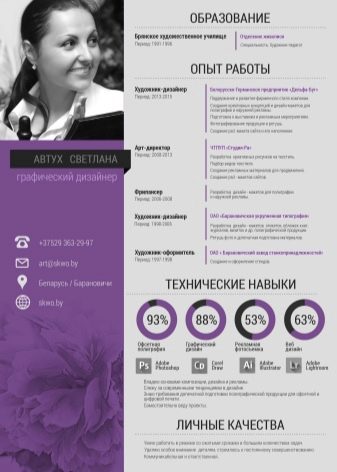
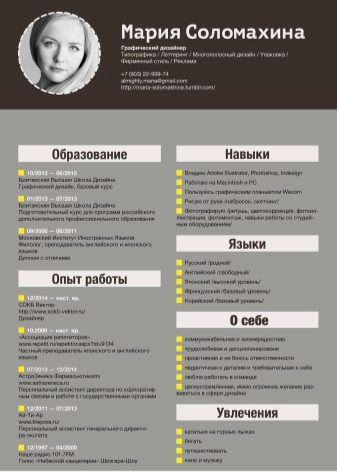
Decor
It is logical that a designer’s resume is not just typed text, in which, apart from information, there is no longer any self-presentation. Your document is comparable with a cognitive map: the future employer looks, reads, sees, remembers. Information should literally be striking. There should not be any long sentences, long listings, or unreadable fonts.
It is logical that The employer is waiting for a creative resume. To do this, you need to think about what visual form will not only make your document memorable, but will also be a business card of your aesthetic preferences. For example, you are a fan of the Shebby-chic style, and very often people turn to you with a request to recreate it. It is logical that the resume was framed in the same recognizable style.
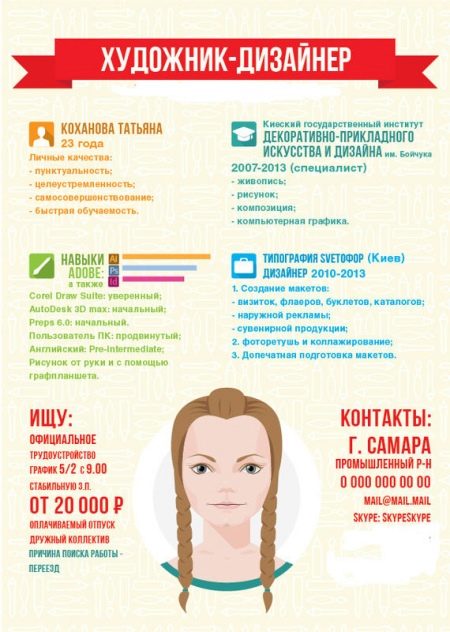
If in a creatively compiled resume a simple list of programs you work for appears, this is no longer a creative approach. Instead of the list there should be logos of programs and applications: they are more recognizable, and you thereby show that the little things are important to you.
The summary may be simple, but it accurately, harmoniously, beautifully and clearly contains information, thought out graphics and textual treatment. And this accuracy helps to notice among others your resume. Do not let the bright design overshadow the content of the document.
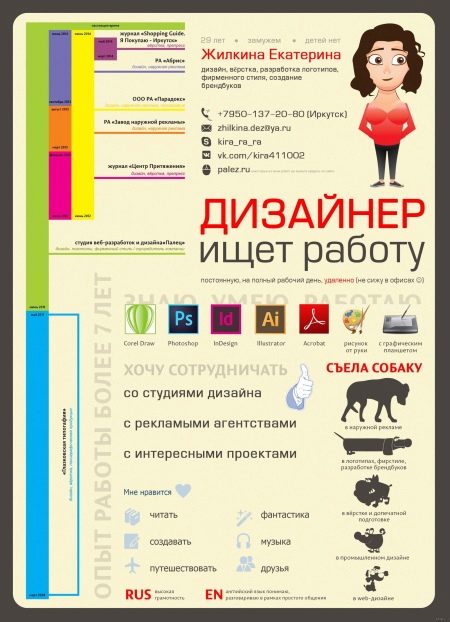
How to write a cover letter?
For the position of designer, you also need a letter of support. This is the first attempt of the applicant to declare himself and make the manager look at your materials in the first place.
The structure of the letter.
- Greeting. Example: “Hello! I’m Elena Grigoryeva, applying for the position of designer-typesetter. I learned about the vacancy from colleagues in the professional community. ”
- Why are you applying for this position (and at the same time why you are interested in it). This should be written in 1-2 sentences. Example: “The position in your company is interesting to me as an opportunity for professional self-realization in a large team with an excellent reputation. And, most importantly, my specialty allows me to become useful for the segment you are developing, the design of scientific journals. ”
- Completion - contacts, farewell. Example: “Detailed information is in the attached summary. Thank you for your attention, I will wait for a response by phone or mail. ”
Try to fill out a cover letter in the same style as the resume.
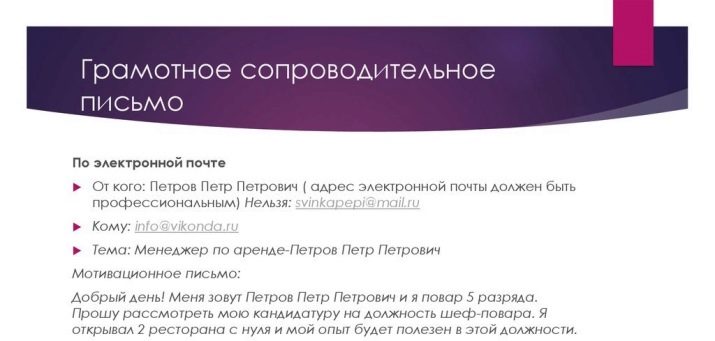
Examples
Creating your own resume is easier on samples and templates. Successful options obey a clear structure, which is necessary for high-quality filling.
Sample CV for interior designer.
Inna Petrovna Gamova
March 22, 1984
Interior Designer, Artist
Contact details: phone, email, instant messengers
Goal - Vacancy Interior Designer at Everest
Education - Novosibirsk State University, Faculty of Graphic Arts, specialty "Teacher of Fine Arts and Drawing", 2002-2007. Moscow School of Design "Origins", March-October 2010
Experience - Since 2012, she worked as a designer at Richter. The reason for leaving is moving to St. Petersburg (for family reasons).
Functional responsibilities:
- development of individual design projects;
- visualization of the interior;
- design of any room in the apartment;
- drawings of furniture according to the sketch of the customer.
Achievements:
- honors diploma of the Moscow school of design "Sources";
- reaching the final of the annual contest of professional excellence “Design Debut of the Year”;
- I have a number of publications in interior magazines (links can be attached);
- diplomas, letters of appreciation and gratitude for educational and enlightening activities in the field of interior design.
Geography of work - Moscow, Samara, Arkhangelsk, Minsk, Helsinki, St. Petersburg.
technical skills - list (or rather, designate with logos the programs in which you work).
Knowledge of languages - English spoken, business correspondence.
Personal qualities:
- responsibility;
- attentiveness;
- good memory, ability to work with large volumes of information;
- fast learner;
- adequate response to criticism.
Interests: photography, writing articles in interior magazines, drawing.
Professional credo: Creating harmony - professionally, precisely, with inspiration.
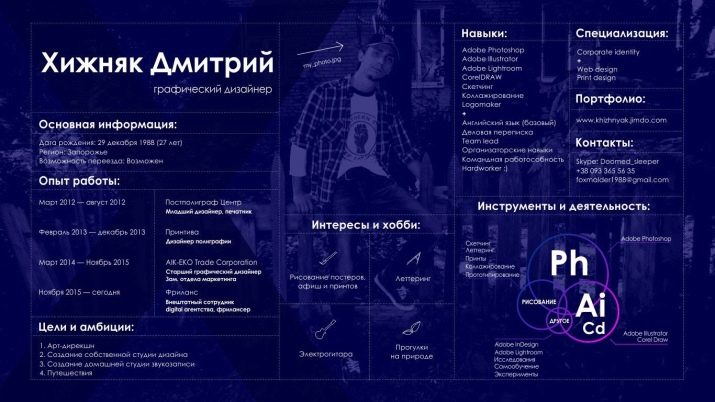
If you place your resume on special job search sites, You can include in it the item “I want to cooperate.”
An example of what to write in this paragraph:
- with design studios;
- with advertising agencies;
- with sewing companies (for a clothing designer);
- with architectural bureaus (for designer-architect).
If you are writing an express resume, which will be the first page in your portfolio, leave only the basic points in it. For example: experience, education, tools, contact details.
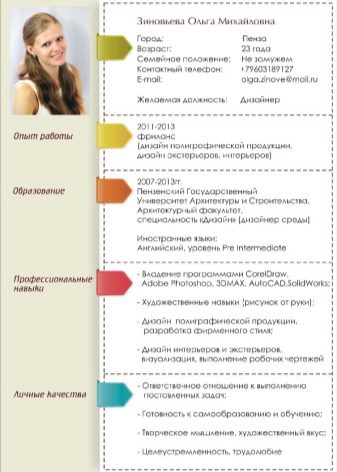
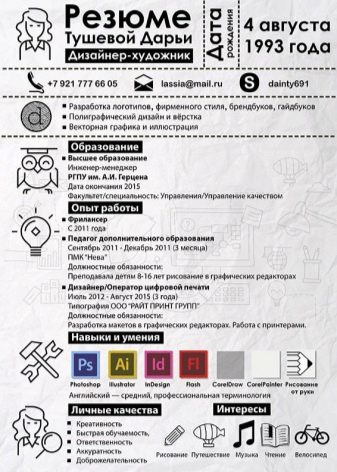
And do not forget to pick a good photo for the resume. Your portrait should correspond to your ideas about artistic taste, aesthetics. And, of course, it should also be memorable: the absentee visual sympathy of the employer is never superfluous.










